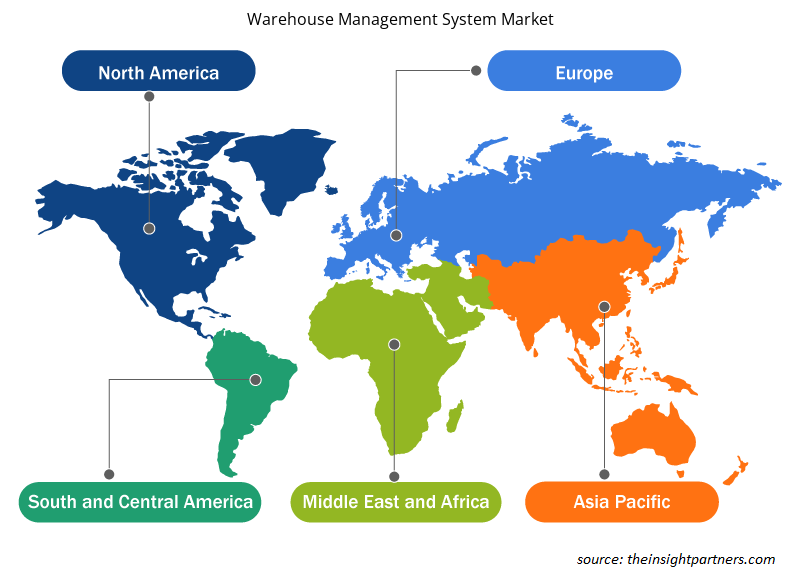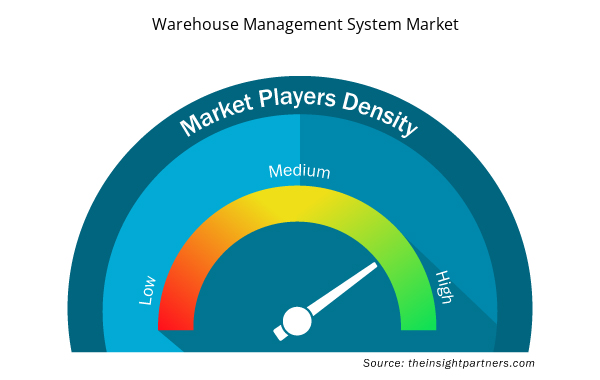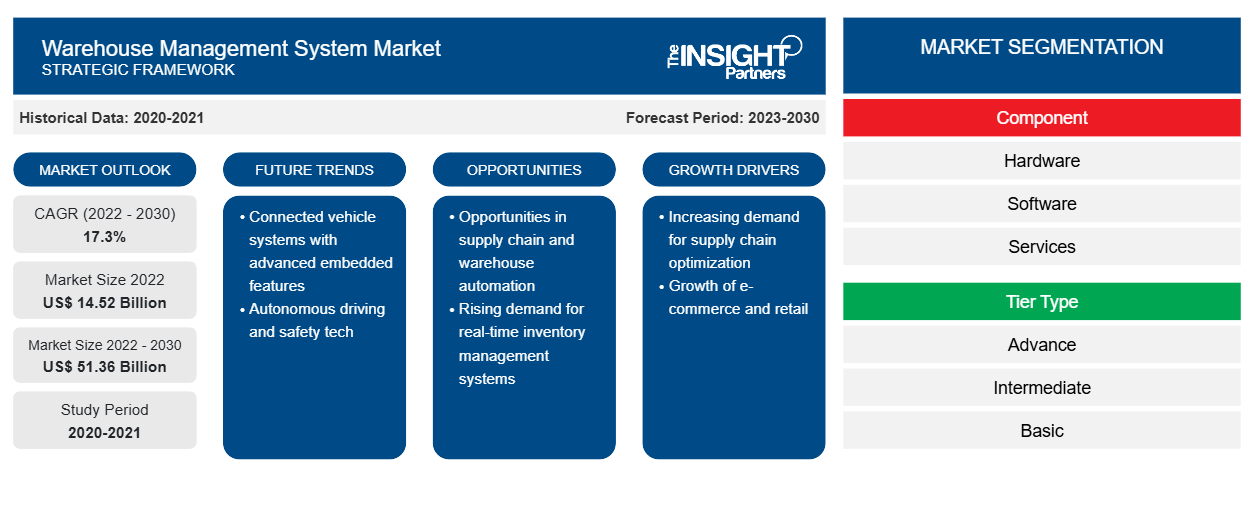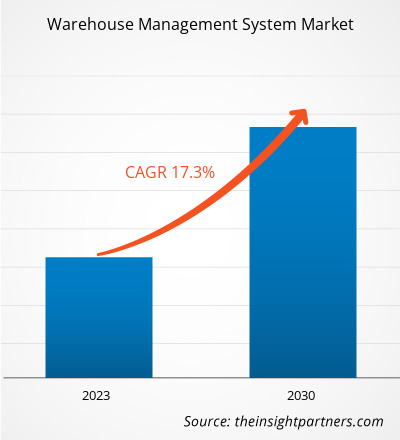倉庫管理システム市場は、2022年の145億1,707万米ドルから2030年には513億6,023万米ドルに成長すると予想されており、2023年から2030年にかけて17.3%のCAGRを記録すると予測されています。
多くの企業は、特にCOVID-19パンデミックの発生後、在庫管理を改善するためにロボット技術を導入しています。ロボット技術の実装により、人件費が削減され、より効率的で正確なプロセスフローが提供され、ロボットは同じコストで24時間365日稼働できます。さらに、人工知能(AI)とモノのインターネット(IoT)と統合されたロボット技術は、企業が倉庫の自動化を改善するのに役立ちました 。ロボット技術と倉庫管理システムの統合により、ロボットに在庫データが供給され、正確で効率的な倉庫業務を実行できるようになります。このような利点が、倉庫管理システム市場の成長を促進しています。
倉庫では、特に製造業や小売業、電子商取引などの業界で、単純で反復的な作業を実行するためにロボットが導入されています。COVID-19パンデミック中の消費者の嗜好の変化により、あらゆる規模の倉庫で、社会的距離を維持し、施設で働くスタッフの数を減らすために自動化がますます導入されています。さらに、ロボットは、体温の測定や手指消毒剤の投与など、労働者の作業を実行するために広く使用されています。多くの物流専門家も、手作業から自動化に移行しています。倉庫のロボット技術は急速に進歩しており、たとえば、ロボットは倉庫内を自律的に移動できます。商品の大量輸送に加えて、ロボットはアイテムのピッキング、梱包、パレット化もできるため、倉庫関連のプロセスが簡素化されます。さらに、電子商取引の人気の高まりにより、WMS全体でロボットの需要が加速しています。オンライン注文の増加と迅速な配送の需要の高まりにより、倉庫とフルフィルメントセンターはロボットシステムを活用して注文の完了を改善し、在庫をより適切に管理しています。倉庫フロア内での商品の取り出しや輸送に費やす時間とリソースを削減するのに役立つロボット ハードウェア システムの需要が高まっています。このシステムにより、作業員は注文の梱包や発送などのより複雑なプロセスに集中できるようになります。
要件に合わせてレポートをカスタマイズする
このレポートの一部、国レベルの分析、Excelデータパックなど、あらゆるレポートを無料でカスタマイズできます。また、スタートアップや大学向けのお得なオファーや割引もご利用いただけます。
- このレポートの主要な市場動向を入手してください。この無料サンプルには、市場動向から見積もりや予測に至るまでのデータ分析が含まれます。
倉庫管理システム市場 -
COVID-19パンデミックが欧州の倉庫管理システム市場の成長に与える影響
ヨーロッパでは、COVID-19パンデミックに対する各国の対応のタイミングと程度、それに続く経済の段階的な再開により、この地域の倉庫管理システム市場に悪影響が生じました。 ヨーロッパの倉庫管理システム市場の主要プレーヤーは、輸出入制限によりサプライチェーンが混乱したため、収益予測が大幅に下降しました。 さらに、特にパンデミックの初期段階での商業スペースでの製造と生産の停止も、この地域の市場に悪影響を及ぼしました。 製造、小売、eコマース、自動車などのいくつかの垂直分野では、消費者がインターネットプラットフォームに急速に移行しているため、WMS製品を採用しています。 さらに、オンラインの食品や飲料、必需品、処方箋の需要が高まり、倉庫の必要性が高まっています。
WMSソリューションの需要の高まりに対応するため、大手企業が複数の国で倉庫を開設しています。その結果、WMSはeコマースやサードパーティの物流企業で人気が高まっています。Amazon、Asos、eBayなどのeコマースの大手企業は、地域全体に新しい施設を設立し、WMSの需要を牽引し続けると予測されています。さらに、この地域でのCOVID-19症例の減少により状況は改善しており、市場は加速しており、予測期間を通じて拡大するでしょう。したがって、倉庫管理システム市場の成長は、COVID-19後に大幅に増加すると予測されています。
市場洞察 – 倉庫管理システム市場
進化するグローバルサプライチェーンネットワーク
サプライチェーン ネットワークの因果関係は比較的単純です。組織は倉庫ネットワーク内で地理的に分散しているため、管理に関する複雑さが増しています。国境を越えてサプライチェーンを管理すると、さまざまな国のユーザーが同じ基盤システムを使用して作業を行うため、規制やローカリゼーションの複雑さにも対処する必要があります。さらに、WMS は、組織がグローバル化によって増大する物流上の負担に対処する上で重要な役割を果たします。主要な WMS ソリューションは、専門的なデータ収集および統合ツールを通じて、これをさらにレベルアップできます。2023 年 1 月、Crave InfoTech は、SAP BTP を使用して構築された cEWM と呼ばれる拡張倉庫管理 (EWM) 用の新製品をリリースしました。これは、オンラインでもオフラインでも倉庫プロセスを合理化するクロスプラットフォームです。倉庫で使用される従来のインターネット ポート アプリは、接続が失われることが多く、それに伴いすべてのプロセス データが失われるため、サプライチェーン全体のボトルネックになります。Crave InfoTech の cEWM アプリはこれらの課題に対処し、プロセスの途中で切断されても、オフラインでもオンラインでも効率的に動作します。さらに、サプライ チェーン管理は、原材料の収集から製造、最終製品の配送まで、商品の途切れない流れを維持することを目的としています。
コンポーネントベースの洞察 – 倉庫管理システム市場
コンポーネントに基づいて、倉庫管理システムの市場規模は、ハードウェア、ソフトウェア、サービスに分類されます。ハードウェアセグメントは、2022年に市場で最大のシェアを占めました。
WMS のハードウェア コンポーネントは、タスクと材料の特性に基づいて床面積の最適な使用方法を分析することで、倉庫のワークフローを最適化します。倉庫は、製品や材料、機器を保管する最適な場所を検討することで、運用コストを削減できます。ハードウェア システムを実装すると、在庫の検索、タスクのインターリーブ、ウェーブ プランニング、注文の割り当て、在庫管理、サイクル カウント、ピッキング、補充、梱包、出荷、労務管理、自動化された資材搬送設備(MHE) インターフェイスなどのコア機能と機能が有効になります。COVID-19 パンデミックの発生により、自動化への進歩が加速し、失業率が急上昇したにもかかわらず、倉庫業務は顧客からの高まる需要を満たすために自動化されました。
倉庫管理システム市場は、コンポーネント、階層タイプ、業界、および地域に基づいてセグメント化されています。コンポーネントに基づいて、市場はハードウェア、ソフトウェア、およびサービスに分類されます。階層タイプに基づいて、市場は高度 (階層 1)、中級 (階層 2)、および基本 (階層 3) に分類されます。業界に基づいて、倉庫管理システム市場は、製造、自動車、食品および飲料、電気および電子機器、ヘルスケア、小売および電子商取引、その他に分類されます。
倉庫管理システムの市場規模は、地理に基づいて、主に北米、ヨーロッパ、アジア太平洋 (APAC)、中東およびアフリカ (MEA)、南米に分類されます。2022 年には、APAC が最大の倉庫管理システム市場シェアを占め、予測期間中もその優位性を維持すると予想されます。この地域は、予測期間中に世界の倉庫管理システム市場で最も高い CAGR を記録することも予想されます。
International Business Machines Corp、SAP SE、Epicor Software Corp、Softeon Inc、Oracle Corp、Panasonic Holdings Corp、Infor Inc、Manhattan Associates Inc、PTC Inc、Tecsys Inc は、倉庫管理システム市場の主要プレーヤーです。
倉庫管理システム市場の地域別洞察
予測期間を通じて倉庫管理システム市場に影響を与える地域的な傾向と要因は、Insight Partners のアナリストによって徹底的に説明されています。このセクションでは、北米、ヨーロッパ、アジア太平洋、中東、アフリカ、南米、中米にわたる倉庫管理システム市場のセグメントと地理についても説明します。

- 倉庫管理システム市場の地域別データを入手
倉庫管理システム市場レポートの範囲
| レポート属性 | 詳細 |
|---|---|
| 2022年の市場規模 | 145.2億米ドル |
| 2030年までの市場規模 | 513.6億米ドル |
| 世界のCAGR(2022年 - 2030年) | 17.3% |
| 履歴データ | 2020-2021 |
| 予測期間 | 2023-2030 |
| 対象セグメント | コンポーネント別
|
| 対象地域と国 | 北米
|
| 市場リーダーと主要企業プロフィール |
|
市場プレーヤーの密度:ビジネスダイナミクスへの影響を理解する
倉庫管理システム市場は、消費者の嗜好の変化、技術の進歩、製品の利点に対する認識の高まりなどの要因により、エンドユーザーの需要が高まり、急速に成長しています。需要が高まるにつれて、企業は提供を拡大し、消費者のニーズを満たすために革新し、新たなトレンドを活用し、市場の成長をさらに促進しています。
市場プレーヤー密度とは、特定の市場または業界内で活動している企業または会社の分布を指します。これは、特定の市場スペースに、その規模または総市場価値と比較して、どれだけの競合相手 (市場プレーヤー) が存在するかを示します。
倉庫管理システム市場で事業を展開している主要企業は次のとおりです。
- パナソニック株式会社
- IBMコーポレーション
- SAP SE
- エピコアソフトウェア株式会社
- ソフトン
免責事項:上記の企業は、特定の順序でランク付けされていません。

- 倉庫管理システム市場のトップキープレーヤーの概要を入手
倉庫管理システム市場のプレーヤーは、高度で効率的なシステムの開発に重点を置いています。例:
- 2023 年、Tecsys は、倉庫内倉庫の e コマース フルフィルメント ソリューションにより、小売業者やブランドが既存の卸売および流通モデルとレガシー システムをそのままに、e コマース フルフィルメントを完璧に実行できるようになることを発表しました。
- 業界クラウド企業のInforは2022年、大手国際製薬企業向けにサードパーティロジスティクスの保管・配送サービスを提供するMoonehがInfor WMS(倉庫管理システム)を導入したことを発表しました。このソリューションは、効率的で効果的な倉庫運営を確立するだけでなく、完全な在庫追跡も実現します。大手サプライチェーンコンサルティングおよびソフトウェア実装プロバイダーのSNSが、このプロジェクトを成功裏に遂行しました。
- 過去2年間の分析、基準年、CAGRによる予測(7年間)
- PEST分析とSWOT分析
- 市場規模価値/数量 - 世界、地域、国
- 業界と競争環境
- Excel データセット



Report Coverage
Revenue forecast, Company Analysis, Industry landscape, Growth factors, and Trends

Segment Covered
This text is related
to segments covered.

Regional Scope
North America, Europe, Asia Pacific, Middle East & Africa, South & Central America

Country Scope
This text is related
to country scope.
よくある質問
The hardware segment led the global warehouse management system market in 2022.
The US, UK, Rest of APAC, Saudi Arabia, and Rest of SAM are the countries registering high growth rate during the forecast period.
The global warehouse management system market was valued at US$ 14,517.07 Mn in 2022
APAC is the fastest-growing regional market in the global warehouse management system market between 2023-2030.
The key players of warehouse management system market are encompassed with International Business Machines Corp, SAP SE, Epicor Software Corp, Softeon Inc, Oracle Corp, Panasonic Holdings Corp, Infor Inc, Manhattan Associates Inc, PTC Inc, and Tecsys Inc.
The key driving factors impacting warehouse management system market growth includes:
1. Migration to Cloud-Based WMS
2. E-Commerce Industry Growth
3. Global Supply Chain Networks
Trends and growth analysis reports related to Electronics and Semiconductor : READ MORE..
The List of Companies - Warehouse Management System Market
- Panasonic Corporation
- IBM Corporation
- SAP SE
- Epicor Software Corporation
- Softeon
- Infor
- Manhattan Associates
- PTC Inc.
- Tecsys, Inc.
- Oracle Corporation
The Insight Partners performs research in 4 major stages: Data Collection & Secondary Research, Primary Research, Data Analysis and Data Triangulation & Final Review.
- Data Collection and Secondary Research:
As a market research and consulting firm operating from a decade, we have published and advised several client across the globe. First step for any study will start with an assessment of currently available data and insights from existing reports. Further, historical and current market information is collected from Investor Presentations, Annual Reports, SEC Filings, etc., and other information related to company’s performance and market positioning are gathered from Paid Databases (Factiva, Hoovers, and Reuters) and various other publications available in public domain.
Several associations trade associates, technical forums, institutes, societies and organization are accessed to gain technical as well as market related insights through their publications such as research papers, blogs and press releases related to the studies are referred to get cues about the market. Further, white papers, journals, magazines, and other news articles published in last 3 years are scrutinized and analyzed to understand the current market trends.
- Primary Research:
The primarily interview analysis comprise of data obtained from industry participants interview and answers to survey questions gathered by in-house primary team.
For primary research, interviews are conducted with industry experts/CEOs/Marketing Managers/VPs/Subject Matter Experts from both demand and supply side to get a 360-degree view of the market. The primary team conducts several interviews based on the complexity of the markets to understand the various market trends and dynamics which makes research more credible and precise.
A typical research interview fulfils the following functions:
- Provides first-hand information on the market size, market trends, growth trends, competitive landscape, and outlook
- Validates and strengthens in-house secondary research findings
- Develops the analysis team’s expertise and market understanding
Primary research involves email interactions and telephone interviews for each market, category, segment, and sub-segment across geographies. The participants who typically take part in such a process include, but are not limited to:
- Industry participants: VPs, business development managers, market intelligence managers and national sales managers
- Outside experts: Valuation experts, research analysts and key opinion leaders specializing in the electronics and semiconductor industry.
Below is the breakup of our primary respondents by company, designation, and region:

Once we receive the confirmation from primary research sources or primary respondents, we finalize the base year market estimation and forecast the data as per the macroeconomic and microeconomic factors assessed during data collection.
- Data Analysis:
Once data is validated through both secondary as well as primary respondents, we finalize the market estimations by hypothesis formulation and factor analysis at regional and country level.
- Macro-Economic Factor Analysis:
We analyse macroeconomic indicators such the gross domestic product (GDP), increase in the demand for goods and services across industries, technological advancement, regional economic growth, governmental policies, the influence of COVID-19, PEST analysis, and other aspects. This analysis aids in setting benchmarks for various nations/regions and approximating market splits. Additionally, the general trend of the aforementioned components aid in determining the market's development possibilities.
- Country Level Data:
Various factors that are especially aligned to the country are taken into account to determine the market size for a certain area and country, including the presence of vendors, such as headquarters and offices, the country's GDP, demand patterns, and industry growth. To comprehend the market dynamics for the nation, a number of growth variables, inhibitors, application areas, and current market trends are researched. The aforementioned elements aid in determining the country's overall market's growth potential.
- Company Profile:
The “Table of Contents” is formulated by listing and analyzing more than 25 - 30 companies operating in the market ecosystem across geographies. However, we profile only 10 companies as a standard practice in our syndicate reports. These 10 companies comprise leading, emerging, and regional players. Nonetheless, our analysis is not restricted to the 10 listed companies, we also analyze other companies present in the market to develop a holistic view and understand the prevailing trends. The “Company Profiles” section in the report covers key facts, business description, products & services, financial information, SWOT analysis, and key developments. The financial information presented is extracted from the annual reports and official documents of the publicly listed companies. Upon collecting the information for the sections of respective companies, we verify them via various primary sources and then compile the data in respective company profiles. The company level information helps us in deriving the base number as well as in forecasting the market size.
- Developing Base Number:
Aggregation of sales statistics (2020-2022) and macro-economic factor, and other secondary and primary research insights are utilized to arrive at base number and related market shares for 2022. The data gaps are identified in this step and relevant market data is analyzed, collected from paid primary interviews or databases. On finalizing the base year market size, forecasts are developed on the basis of macro-economic, industry and market growth factors and company level analysis.
- Data Triangulation and Final Review:
The market findings and base year market size calculations are validated from supply as well as demand side. Demand side validations are based on macro-economic factor analysis and benchmarks for respective regions and countries. In case of supply side validations, revenues of major companies are estimated (in case not available) based on industry benchmark, approximate number of employees, product portfolio, and primary interviews revenues are gathered. Further revenue from target product/service segment is assessed to avoid overshooting of market statistics. In case of heavy deviations between supply and demand side values, all thes steps are repeated to achieve synchronization.
We follow an iterative model, wherein we share our research findings with Subject Matter Experts (SME’s) and Key Opinion Leaders (KOLs) until consensus view of the market is not formulated – this model negates any drastic deviation in the opinions of experts. Only validated and universally acceptable research findings are quoted in our reports.
We have important check points that we use to validate our research findings – which we call – data triangulation, where we validate the information, we generate from secondary sources with primary interviews and then we re-validate with our internal data bases and Subject matter experts. This comprehensive model enables us to deliver high quality, reliable data in shortest possible time.


 このレポートの無料サンプルを入手する
このレポートの無料サンプルを入手する